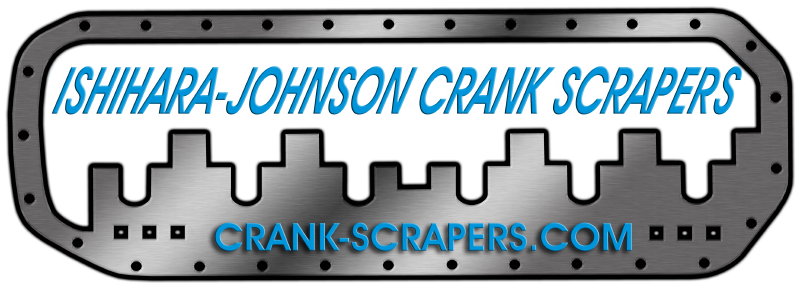
(727) 808-8602
| Home | Latest New Products | Customers' Rides | Orders, Terms and Conditions |
| What a crank-scraper is and other technical info... | Some comments on our products... |
|
(727) 808-8602
|
We can do custom stroker or knife-edge crank designs. We can provide templates for initial fitting and adjustment. Templates cost $100 and are a separate charge from the scraper pattern chosen.
We have included some representative pictures of the scrapers we make. If you would like to see a picture of a particular scraper please ask -- we would be more than happy to send one through.
When available (please enquire) our zero-clearance Teflon® scrapers run an additional $130.00 to the cost of the standard steel scraper unless noted.
Remember, your vehicle may have an engine made by a different manufacturer so check both product lines. If you are still unsure, please contact us.
crankscraper, crank-scraper, crank-scrapper, crank, crankshaft, rod-bearing, main-bearing, connecting-rod, counterweight, piston, windage, windage-tray, windage-cloud, oil pan, oil-pan, oil-aeration, oil-foaming, oil-cloud, racing, drag racing, road racing, drag-race, road-race, road-course, drift, drifting, time-trial, performance, power, horsepower, HP, torque, TQ, friction, vacuum, economy, engine, motor
|
|
When the oil in the 928 or 944 circuit has free air bubbles in it, it is subject to stratification by density when it undergoes acceleration. When this mixture goes around turns or bends in the galleries the denser fraction is pushed to the outside and the lighter density fraction, i.e. free air bubbles, is pushed to the inside or shorter radius. The oil entering the main passageway has just undergone turns and so the air/oil mixture is already segregated. Very shortly thereafter this segregated mixture reaches the side passage leading to the 2/6 or 2 rod bearing circuit. In making this turn the heavier density fraction, oil, will create a boundary layer and will channel the already segregated air bubbles to the shorter inside radius. In this way, the number 2/6 or 2 rod bearing receives a higher relative/local percentage of entrained air than the other passages. This is fatal for reasons which are well explained in SAE papers. [See, for example,SAE 932785] After passing by the 2/6 or 2 side passage to subsequent passages two advantages appear: 1) the average mix has a lower entrained air percentage by virtue of a disproportionate amount of air being already directed to the 2/6 or 2 passage; 2) the segregated air and oil has a chance to redistribute more randomly -- this makes subsequent corner flow radial accelerations less damaging. Further comments on the 944/951/968: The Porsche 944 has an oiling system where the main oil gallery is appended to the exterior surface of the block* and comprised of two converging cones with the narrow tips being joined at approximately parallel to the center main of the bedplate.
|
|
Copyright 2002-2026 © All rights are reserved on our product designs -- a great deal of hard work goes into each one. Teflon® is a registered trade mark of E.I. du Pont de Nemours and Company. Only DuPont makes Teflon® resin sourced by Ishihara-Johnson Crank Scrapers from authorized DuPont licensees. We Ship
|